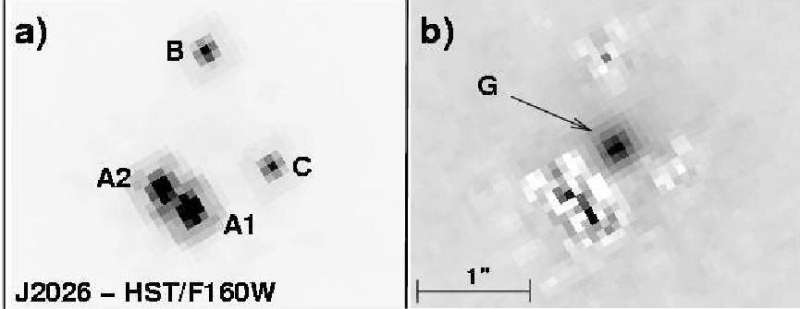Microlensing measurement of a quasar's accretion disk

An active galactic nucleus (AGN) is a supermassive black hole residing at the core of a galaxy that is accreting material. The accretion occurs in the vicinity of the hot torus around the nucleus, and it can generate rapidly moving jets of charged particles that emit bright, variable radiation as material ccelertes as it falls inward. Quasars are perhaps the best-known luminous AGN, and their nuclei are relatively unobscured by dust. Quasar nuclear regions and disks are too far away and much too small to be resolved with telescopes and astronomers trying to understand the behavior of quasars, AGN, and accretion disks are forced to infer the physics from indirect measurements. Flux variability measurements offer one such avenue.
Microlensing refers to the short flashes of light produced when moving cosmic bodies, acting as gravitational lenses, modulate the intensity of light from background sources. Because the path of light is bent by the presence of a mass, material bodies can act like gravitational lenses to distort the images of objects seen behind them. Microlensing offers an opportunity to measure the sizes of quasar AGN. Lensed quasar images are occasionally found that have been magnified and distorted into multiple images by a foreground galaxy and the stellar objects within it. As the quasar moves relative to our line of sight, this magnification changes, generating significant uncorrelated variability between the images over months or years. If the time delays between the multiple images of the quasar are monitored closely enough during multiple epochs it is possible to unravel the intrinsic quasar variability from the microlensing variability. Only fourteen multi-epoch size measurements of quasars have been made until now.
CfA astronomer Emilio Falco was a member of a team that used these variability techniques to estimate the size and mass of the accretion disk and black hole in the quasar WFI2026-4536, a quasar so distant that its light has been traveling towards us for nearly eleven billion years; the age of the universe is only 13.7 billion years. The scientists analyzed optical light variability data over thirteen years, from 2004 to 2017, and developed lensing models that were able to constrain the size of the quasar's accretion disk to about three hundred and sixty astronomical units and the mass of its supermassive black hole to about one and one-half billion solar-masses. The mass is in rough agreement with other expectations and with the range of masses in the fourteen other similarly measured quasars, but about twice as large as expected from methods based on the luminosity. They also report the first mass measurements of the central black hole using spectroscopic data, with results consistent with the variability method. The impressive results further refine our understadning of these distant monsters and refine the models of AGN.
More information: Matthew A. Cornachione et al. A Microlensing Accretion Disk Size Measurement in the Lensed Quasar WFI 2026–4536, The Astrophysical Journal (2020). DOI: 10.3847/1538-4357/ab557a
Journal information: Astrophysical Journal
Provided by Harvard-Smithsonian Center for Astrophysics


















